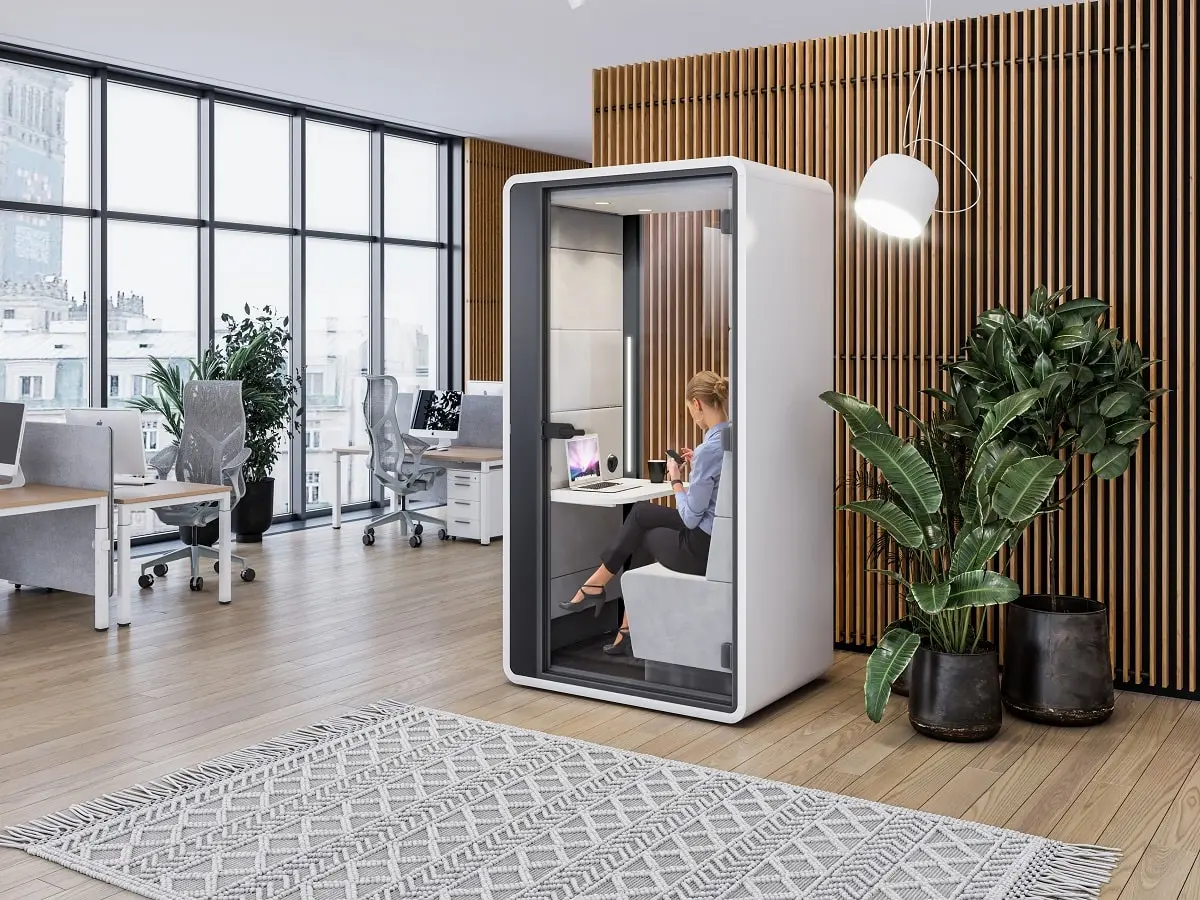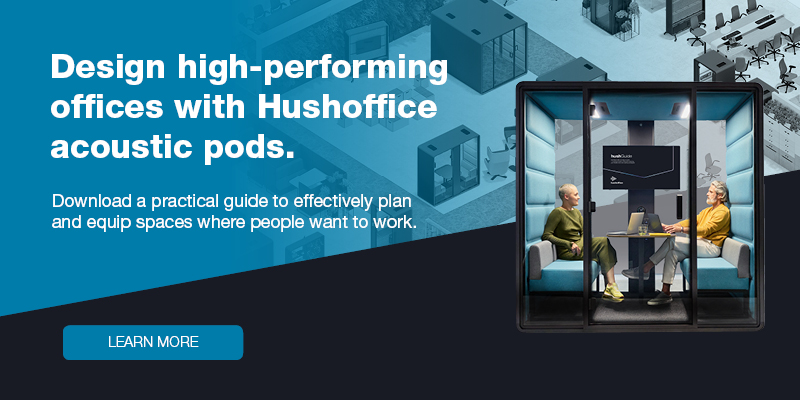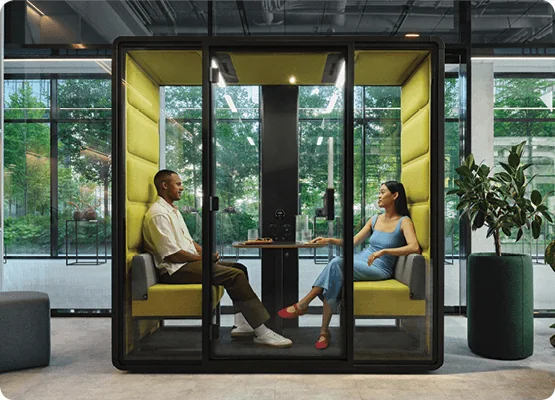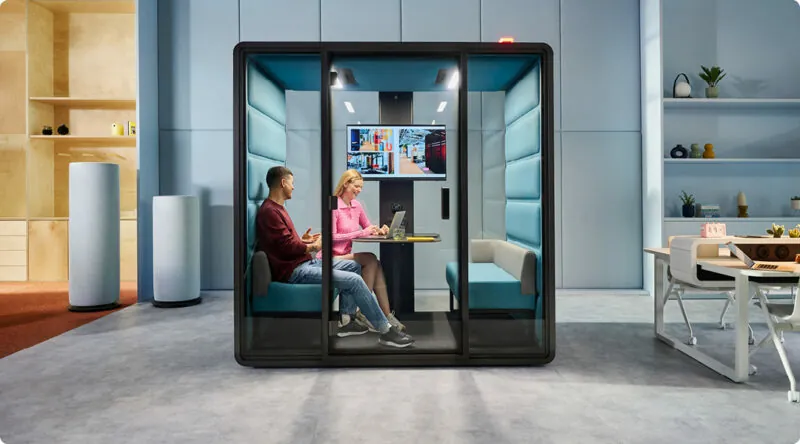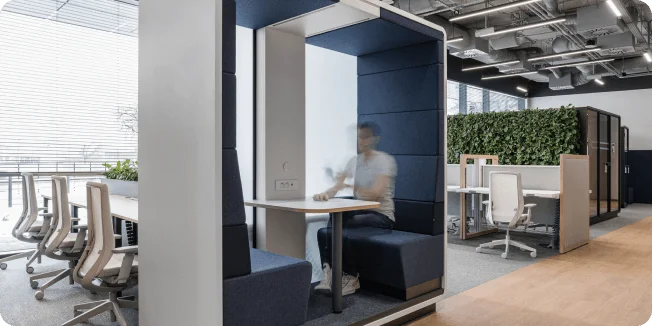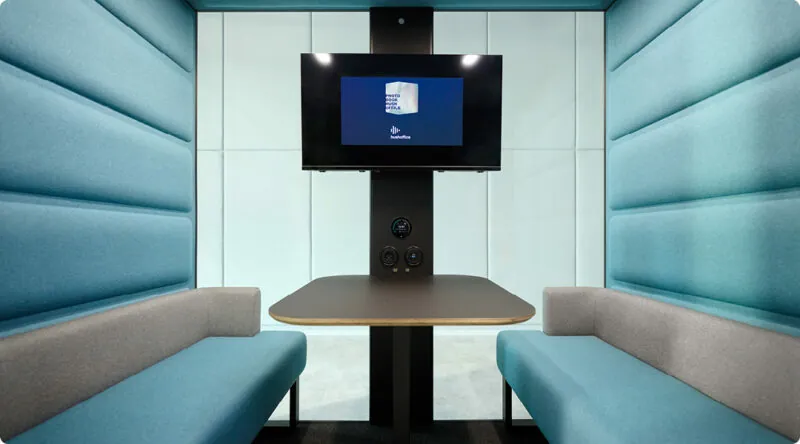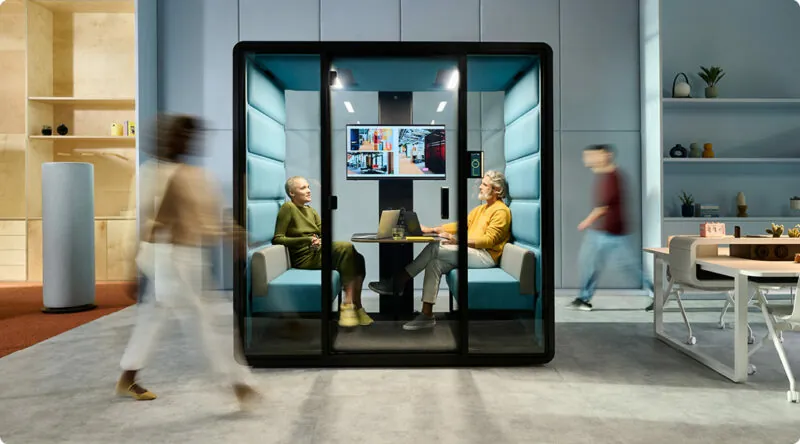Acoustic pods — the perfect place for employee feedback?
- Posted on: 3 April 2024
- By: Hushoffice Team
92% of employees prefer to get feedback more frequently than a once-annual performance review allows. In fact, 49% want formal feedback from their manager at least weekly – 72%, monthly. Where is the best place in the office to hold these discussions? Acoustic booths, we think. Here’s why.
92% of employees prefer to get feedback more frequently than a once-annual performance review allows. In fact, 49% want formal feedback from their manager at least weekly – 72%, monthly. Where is the best place in the office to hold these discussions? Acoustic booths, we think. Here’s why.
Creating psychologically safe meeting spaces for employee performance reviews (and the like) – tl;dr
Low-stimuli spaces are best. When overcome with information or noise, the brain struggles and even partially shuts down. This happens because the body responds to too much information by absorbing serotonin, the happiness neurotransmitter. This is problematic, knowing that a healthy amount of serotonin is needed to maintain an apt mood for delicate discussion.
Keep your meeting spaces relatively small. Simply sitting close to a person boosts your empathy for them, and vice versa. Reciprocated empathy is of course an integral component of a productive check-in.
Make the lighting adjustable wherever possible. While bright lights stimulate emotions, dim lights are slightly sedating, allowing for slow, rational, emotion-free thinking. Whenever balance between these ends of the spectrum is needed, user-controlled lighting comes to the meeting host’s aid.
Pay special mind to every meeting space’s furniture. While rounded seating layouts tap into the human desire to belong, rectangular seating layouts let a group designate the table’s head, instilling any desired power structure. Moreover soft furniture encourages more lenient negotiation, while rigid furniture encourages rigidity.
What does a peaceful environment matter in employee appraisals?
Elements like noise, visual clutter, stark, eye-tiring lighting, and peripheral activities make a space unpeaceful. Chaos defeats an individual’s ability to zero in and meet with focus! When it comes to performance reviews, challenging by nature, this defeat has serious implications.
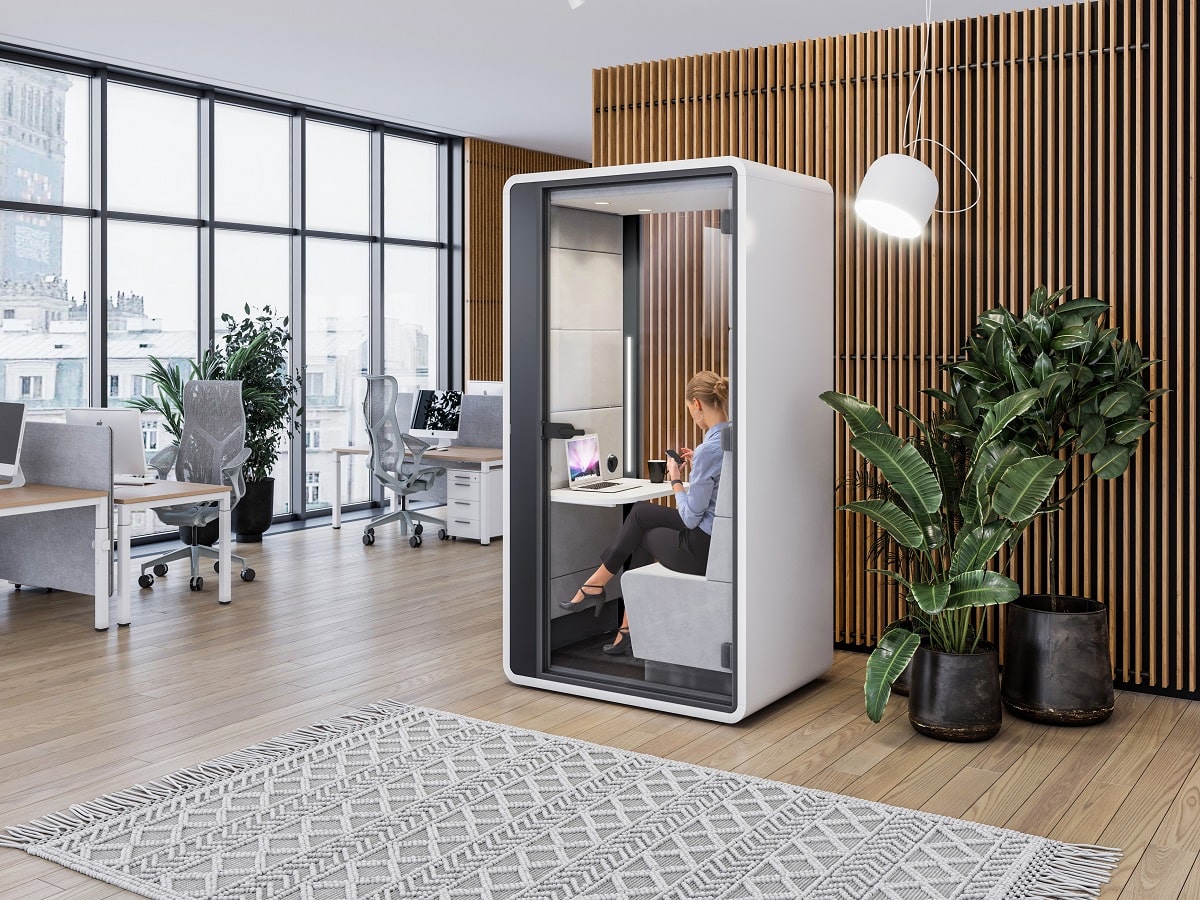
When it comes to giving employee feedback, there are a handful of general rules that guide the discussion in the right direction. You should aim to be as crystal clear as possible in your critique, staying specific. And be sure firstly your colleague is receptive, in the right headspace to listen, so as not to force unsolicited advice. Similarly, empathy is a key piece — or a real depth of care to guide the correspondence toward shared understanding. And the most important support for a fruitful one-on-one is arguably a private meeting space like hushMeet. Your meet space should be comparably sound-insulated. Only ultimate security gives employees peace-of-mind, for candid back and forth
– says Mateusz Barczyk, Senior Brand Manager, Hushoffice.
Our physical environment influences our openness and honesty.
The office environment has a great influence on employee attitudes, behaviors, satisfaction, and work performance. While acoustic insulation allows us to be forward without worry about judgment, background noise deters flowing conversation by repeatedly breaking its focus.
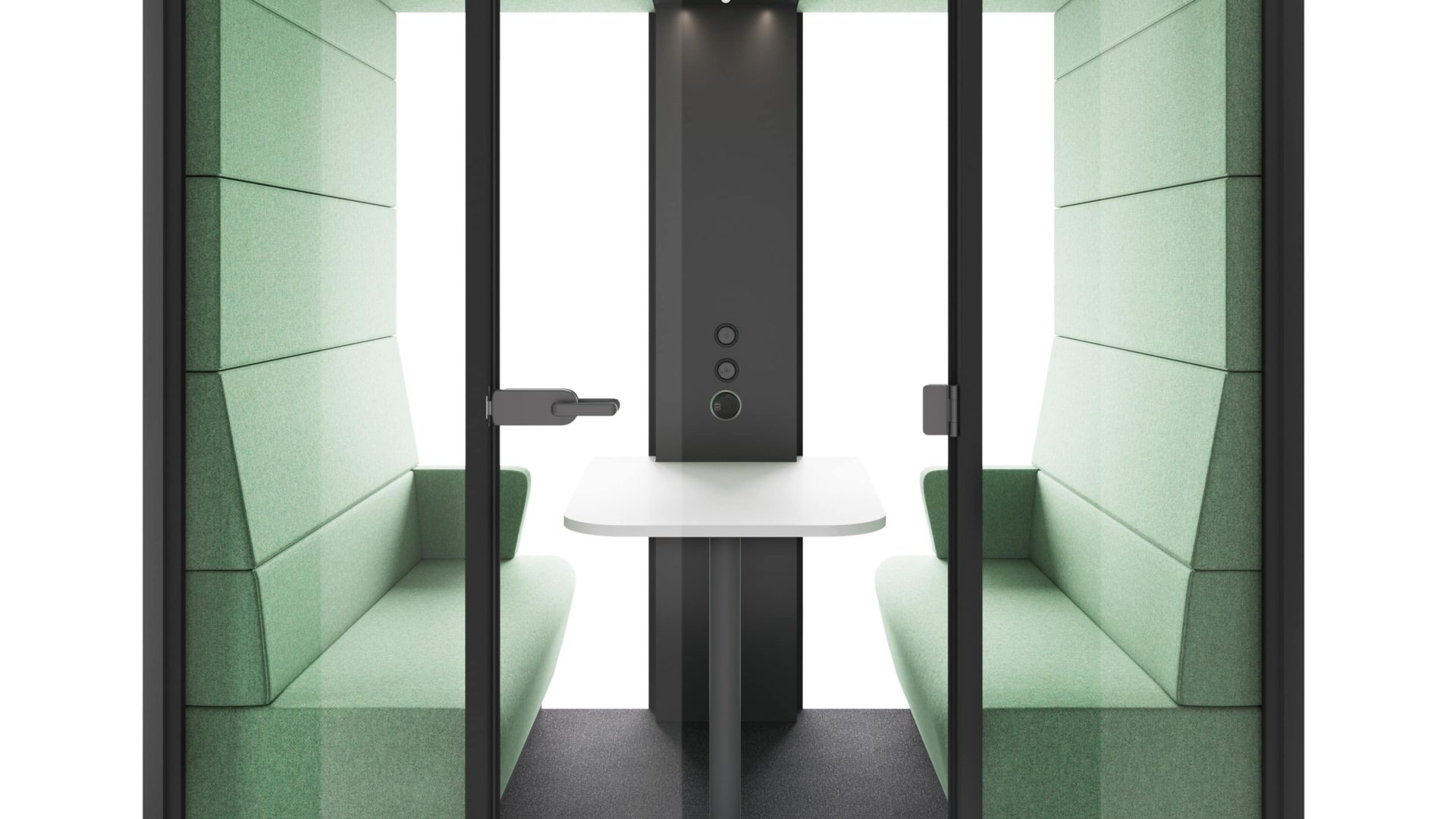
It all hinges on emotional security, or psychological safety.
Psychologically safe employees share thoughts and concerns frankly, uninhibited by fear of reprisal. During a review, this delicate sense of security is the difference between a constructive or destructive effort. People are plainly more able to engage when they feel safe doing so.
Architect Donald M. Rattner’s extensive research on the psychology of spaces offers bright guidance for the work of creating safe spaces in the office. Safe spaces being, of course, requisite to well-received feedback. It is apparently so that employees generally favor soft furniture pieces with curved lines over hard edges. Softness signals safety. In a similar vein, research shows the workplace should be artfully made to feel a touch more like home. Made such a place of refuge, the office is familiar and conducive to fluid exchange, home being perhaps the most powerful imparter of safety. Thinking over Rattner’s scientifically-based suggestions, we find that pods and booths are an attractive option for private meeting spaces. Professional but finely cozy, with supportive seating and upholstered interior panels to set off their functional look, private pods like Hushoffice may be just the shelter employees need to feel at ease during an appraisal
– says Mateusz Barczyk, Senior Brand Manager, Hushoffice.
A sense of physical privacy is a strong foundation for emotional security at work.
Our ancestors sought shelter for their safety. Similarly, workplaces need settings that offer calmness, solitude. These spaces might resemble caves in some fashion – like low-stimuli dens where employees can find refuge from office noise, and a feeling of protection and separation.
Acoustic cabins are a psychologically safe place for effective performance reviews.
Architecture plays a big role in a space’s feeling of safety. Most universally, areas which are quiet, visually calm, and fit with adequate softness in the form of upholstery or cushion seating feel safe to people. And a space must be physically enclosing to some degree to feel truly safe.
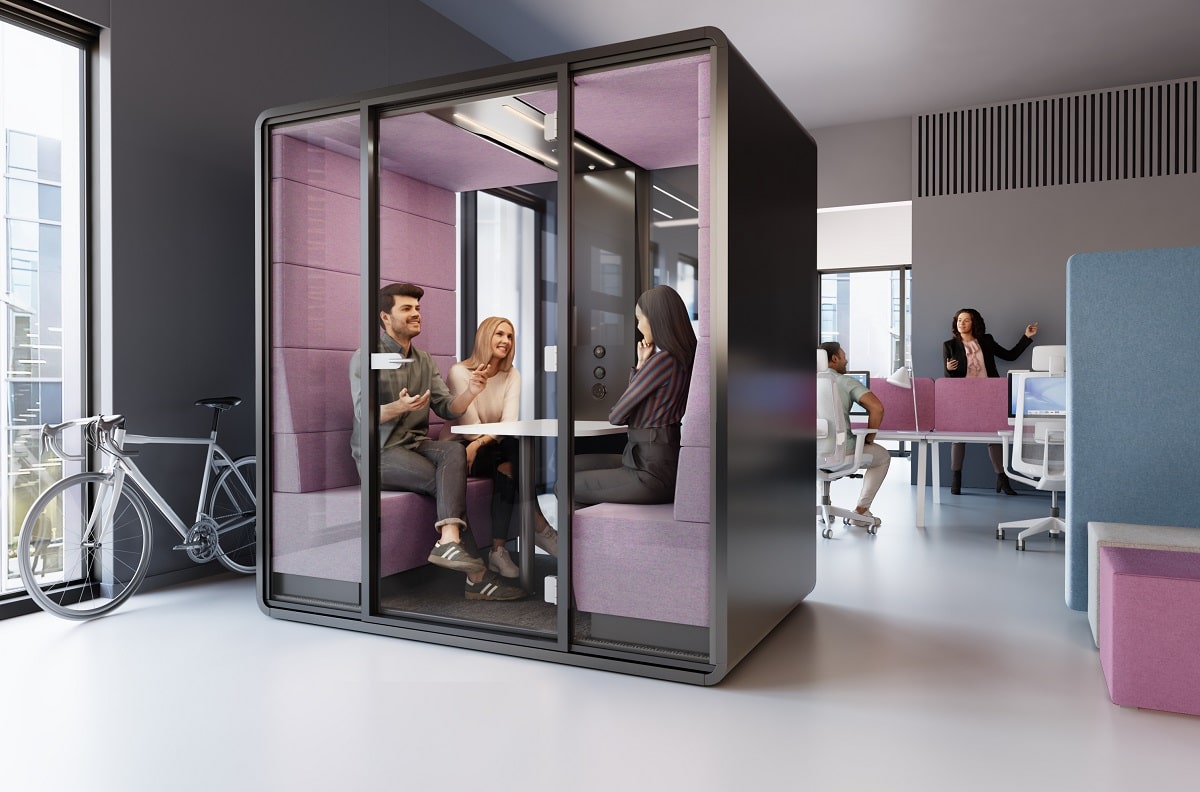
Office pods and booths give a remarkable degree of peace.
Interestingly, soft furniture influences people to negotiate more flexibly, while rigid chairs give rigidity. Pods are sleek, polished, while cozy, with soft seating. Without a doubt, such interiors designed with comfort in mind make people feel more secure and able to connect with each other.
Booths block out office noise, bettering everyone’s state of mind.
When overloaded with information, the brain struggles and may even partially shut down. This is because the body responds to “TMI” by absorbing serotonin, a neurotransmitter of happiness and calmness. Less serotonin naturally leaves us feeling anxious or depressed.

Small and homey, office pods promote shared understanding between parties.
Simply sitting close to someone boosts your empathy for them. Mutual empathy is requisite to new understanding — so that two people can move through a challenge together. Office pods are a compact meeting space that promotes such intimate discussion wherein everyone is easily heard.
Acoustic work booths improve focus and rapport by limiting noise.
Noise increases stress hormones like norepinephrine, making it harder to concentrate, reducing one’s sensitivity to others. Noise may simultaneously decrease one’s attention span and, ultimately, their comprehension. Booths block sound out, allowing for deep, sustaining presence.
Conversations held in an acoustic cabin are easier and more productive.
Sound-insulated for impeccable, noise-free speech. Adjustable ventilation for enduring comfort through long correspondences. User-set lighting, allowing meeting attendees to achieve the right level of intimacy. Office cabins are the place for one-on-ones.

Employee engagement and performance both hinge on regular feedback.
80% of employees who receive meaningful feedback each week are fully engaged. And astoundingly, employees are 3.6X more likely to be motivated toward exceptional work when their manager provides daily (v. annual) feedback.
Feedback on the open floor v. in the hushAccess.L booth. Chaos v. calm.
Meeting in an open space is subject to constant stimuli. Meeting in a pod like hushAccess.L keeps the subject of the matter at hand in clear, uninterruptible focus.
HushAccess.L is a particularly great meeting booth by multi-purposeness because it can be ordered with or without furniture. So you have liberty in making it the very space your team needs. Furniture is of course a major element, in fact having a predictive influence on the way a meeting goes. Three studies have indeed demonstrated the significance of seating arrangement shape, specifically. Circular-shaped layouts prime a desire to belong, fostering smoother consensus, for instance. So with a booth like hushAccess.L, you get acoustic excellence. And perfect privacy. And the ability to furnish its ready interior to fit your requirements, whether you need a more rectangular table to designate a head, or a round table to engender democratic consensus
– says Mateusz Barczyk, Senior Brand Manager, Hushoffice.
Check out the Hushoffice collection of acoustic office booths for inspiration.
Creating psychologically safe meeting spaces for employee performance reviews (and the like) – summarized
Low-stimuli spaces are best. When overcome with information or noise, the brain struggles and even partially shuts down. This happens because the body responds to too much information by absorbing serotonin, the happiness neurotransmitter. This is problematic, knowing that a healthy amount of serotonin is needed to maintain an apt mood for delicate discussion.
Keep your meeting spaces relatively small. Simply sitting close to a person boosts your empathy for them, and vice versa. Reciprocated empathy is of course an integral component of a productive check-in.
Make the lighting adjustable wherever possible. While bright lights stimulate emotions, dim lights are slightly sedating, allowing for slow, rational, emotion-free thinking. Whenever balance between these ends of the spectrum is needed, user-controlled lighting comes to the meeting host’s aid.
Pay special mind to every meeting space’s furniture. While rounded seating layouts tap into the human desire to belong, rectangular seating layouts let a group designate the table’s head, instilling any desired power structure. Moreover soft furniture encourages more lenient negotiation, while rigid furniture encourages rigidity.
Performance reviews – frequently asked questions
How often should I hold employee performance reviews?
92% of employees like to receive feedback more often than a once-annual performance review allows. 49% want feedback from their manager at least weekly. 72% want it monthly. Incredibly, employees are 3.6X more likely to be motivated toward exceptional work when their manager give daily (v. annual) feedback.
What is psychological safety at work?
Employees feel comfortable taking interpersonal risks, without fear of negative consequences. For example, in a psychologically safe workplace, team members exchange diverse viewpoints during meetings without worrying about criticism or ridicule.
How can office design promote psychological safety?
By creating spaces where people can collaborate openly but also find privacy when needed, offices can help foster a sense of belonging and trust among colleagues. These elements form the basis of psychological safety. Having areas where to gather for casual discussions, for instance, or break as a group means natural interaction and strengthened bonds. Simple things like natural light and greenery can also make the office feel a great deal more human, welcoming, and workable. The most important aspect however may be the provision of privacy — since the dawn of time, humans sought shelter for safety. In the office, this looks like Hushoffice booths, which are private and peaceful.
